Coorg Tour Guide
History of Coorg: Originally known as Kodaimalenadu, Coorg (or Kodagu) is a little hill-station that covers an area of 4102 sq km. It is located on the Western Ghats of Karnataka, bordering the state of Kerala. With its breathtaking beauty and virginal atmosphere, it is a much-favored destination from travel and tourism point of view. The martial race of Coorgs (Kodavas), the largest local tribe of the place, with the chivalrous streak in their nature and gallantry, add to the rich culture and indigenous history of the place. This beautiful land of the “Kodavas” is famous as “The Land of Warriors”.
With its verdant valleys, sleepy hills, serpentine streets, scintillating mountains and its mystic air, its unsurpassed beauty is also heightened by acres and acres of tea and coffee plantations that stretches across the place. Lofty teakwood and sandalwood trees abound the place and enhance its grandeur manifold. Coorg is even termed as the “Orange Country”, for its innumerable orange groves. With the rich and inviting aroma of coffee, sandalwood and oranges, Coorg provides a treat to your olfactory senses, coupled with its visual delights. In fact, its district capital, Madikeri, is popularly known as “the Scotland of India”. 
Coorg has something or the other to offer to everyone who visits and explores its enticing and exciting little domain. With facilities for various adventure sports like golfing, trekking, angling etc amidst the rugged beauty of its majestic mountains, it is a perfect getaway for the adventure lovers. Its beauty is equally gripping for people who trot to hill stations to escape their tumultuous lives in the noisy metropolis. With the mellifluous chirping of birds, the gurgling waterfalls and the romantic mountain breeze, it is the perfect place to mingle with the placidness of nature’s wealth.
If you are someone who love pampering yourself, Coorg certainly has options for you. With its famous ayurvedic and therapeutic massages, you can rejuvenate your mind and just relax on its lap, enjoying the panoramic view of the Arabian Sea. You can even visit various religious sites in Coorg, to experience its mysticism and spiritual flavor. So, what are you waiting for? Get ready for an unsullied experience in Coorg, with its mist-covered mountains, aromatic coffee bushes and spices, salubrious air, meandering waterfalls and rolling paddy-fields. And yes, don’t forget to go around and see some of the most exotic hamlets and villages around the city on your trip.
Coorg Weather
Best time to Visit: September to March
Altitude: 1,525 m above sea-level
Summer Temperature: Minimum: 25oC; Maximum: 35oC
Winter Temperature: Minimum: 9oC; Maximum: 20oC
Coorg Tour Guide
Coorg (Kodagu) is a famous hill station nestled in the Western Ghats of the Sahyadri mountain range, in the state of Karnataka. It enjoys a very moderate climate throughout the year, which makes it a highly preferable holiday getaway for tourists from all parts of the world. Winters in Coorg are chilly but very pleasant. The maximum temperature during the winters is 20 deg C and the minimum temperature goes down to 15 deg C. 
However, during the months of December, January and February, the temperature may fall down to a minimum of 9oC also. During summer season, the temperature might rise to a maximum of 35 deg C and goes down to a minimum of 25 deg C. The summer months are comparatively warmer, but the heat is welcoming, as is the case with most hill-stations. Monsoon acts the harbinger of resplendent greenery. With its onset in June, the whole place blooms in all its vivacity and fervor.
Coorg experiences heavy rainfall during the months of June, July and August and these incessant showers make the weather cool, wet and humid. The beauty of its seasonal waterfalls can be best experienced during the months of July to September. During the months of April-May, the whole place is filled with the refreshing aroma of the coffee blossoms, with the blossom shower in March. Though the beauty of this place is enjoyable throughout the year, the best time to visit it is however between the months of September and March.
Coorg People
Coorg is a land of the generals and beautiful women. Coorgs or Kodavas as they are locally known, are the only race in India who are exempt from the Indian Arms Act and are permitted to possess guns without license. Their customs are unique. Though Coorgs are Hindus, priests do not perform their marriage rites. These fair complexioned men and women with distinctly long noses belong to a martial race. Though they do not belong to mainstream Hinduism, the Coorgs are Kshatriyas (warrior class), according to renowned sociologist Dr M.N. Srinivas. “Coorgs being a hardy race of highlanders are given to bodily skills of dancing and other competitive games like hunting, shooting, etc., which are attributed to the Kshatriyas,” says Dr Srinivas who has done extensive research on the Coorgs’ way of life. 
The customs of Coorgs are different from that of other south Indians. When a son is born in a family, a single shot is fired in the air to greet the newcomer. Similarly, when a Coorg dies, two simultaneous shots are fired in the air to alert the neighbours. Coorgs are legendary for their hospitality. Pork, cooked with vinegar derived from wild berries, is a delicacy served at important feasts.
The Coorgs worship guns. The festival of Keil Murtha, is solely dedicated to the worship of guns. The harvest festival of Puttari is ushered in by firing a gunshot.
Though Coorgs are distinct from other south Indians, they speak a Dravidian dialect, which is mixture of Kannada, Tamil and Malayalam languages.
Coorgs are free from the caste system. Despite being Hindus, ancestor worship called “Karana”, takes precedence over the worship of other Gods in the Hindu pantheon. Coorgs are nature worshippers and they revere river Cauvery. It is their holy river, as river Ganga is to other Hindus. Coorgs get themselves blessed by touching the feet of their elders thrice.
The ceremonial dress of Coorgs is unique in south India. Men wear long knee-length black coat with sleeves cut short at the elbow; a scarlet and gold sash; silver-sheathed ornate dagger; gilted turban. The women wear their sari in a different way by tucking the pleats at the back, unlike the typical Indian way of pleats being tucked in the front. Coorg weddings are something out of this world. The bridegroom claims his bride after a member of his party “kills” mock soldiers in the form of banana trunks. After a sumptuous meal, the Coorg men and women burn their calorie by performing vibrant traditional dance.
But who are these Coorgs? This is a standing riddle which the ethnologists are yet to crack. There are any number of theories on their origin, but none scientific enough to establish the origin of this fine race. The theories range from Coorgs being the descendants of Alexander the Great who invaded India to a band of Kurds from the Iraq region who fled to India to escape conversion into Islam. But there is something extraordinary about these people who gave free India its first Commander-in-Chief of the Army Field Marshal K.M. Cariappa and the soldier’ s general K.S. Thimmayya. Coorg women occupy a predominant place in the community. Among these highly educated women, there is no dowry system, unlike other Indian communities.
How to Reach Coorg
Reaching Coorg – the breathtaking land of the ‘Kodavas’, located atop the Sahyadri Mountain range, is not a problem at all. It is well-connected to all the major cities and states of India through an extensive communication network. If you plan a vacation to this place, there are various feasible options for you to choose from; according to your preference, convenience and budget. In the following lines, we have provided information on how to reach Coorg. 
By Air
The nearest airport to Coorg is Mysore, which is 120 km from the hill station. The second nearest is in Mangalore, which is located at a distance of 135 km from it, followed by the Bangalore Airport, located about a distance of 250 km. You can easily fly from any place in India or abroad, to one of these airports, and then board a private taxi, bus, or car for reaching Coorg.
By Road
If you plan your tour by road, Coorg has a well-connected network of roads that connects it to most of the important cities in Karnataka. The roadways connect cities like Mysore (120 km), Hassan (115 km), Mangalore (135 km), Bangalore (250 km) to Coorg by a well-maintained system of roadways. You can enjoy the scenic beauty of the place to the fullest, while traveling by road, either in a public carrier or in your own vehicle.
By Train
The railhead situated nearest to Coorg is in Mysore, at a distance of 55 kms, and is a drive of two and a half hours from the place. Mysore has an extensive network of railways that easily connects it to the rest of India. One can even avail trains, in the nearby cities of Mangalore or Hassan for getting to Coorg.
Places to See in Coorg
One of the most fascinating hill stations in India, Coorg is famous for its enchanting landscape and its natural bounty. A treasure trove for Karnataka’s Tourism Industry, it is one of the most frequented hill-stations in South India. An ideal abode of peace and resplendence, the place harbors some of the major tourist spots of the country. Find out more about its various tourist attractions that can be included in the sightseeing tours to the place.

Madikeri
The district headquarters of Coorg and a picturesque town atop the Sahyadri mountains, Madikeri is known as the Scotland of India. Formerly known as ‘Marcera’, it is located at a distance of 252 km from Bangalore and is placed at an altitude of 1525 m (5000 ft) above sea level.
Madikeri Fort
In Architecture, Madikeri is unusual. Built on high grounds, the Madikeri Fort looms large over the town. This was rebuilt between 1812-1817. At the entrance stands the majestic sculpture of horses erected on the entrance wall.Within the fort is the palace which now houses government offices. The palace is built in European style with secret underground routes. Now a stone structure of tortoise stands as a witness to it. There are initials of Virarajendra marked ‘V’ here and there. As a mark of regret for the brutal killing of the royal elephant by King Vira raja stone replicas of two mighty elephants stand nearby.
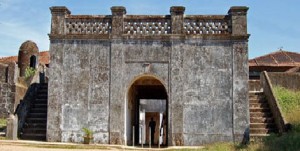
Nagarahole National Park
This wildlife sanctuary, which shelters elephants, tigers, spotted deer, leopards, bison, peacocks and other exotic wildlife, is a favorite among the tourists. There are lodging facilities inside the park, which makes it a much-visited tourist spot. Nagarhole National Park is also known as ‘Rajiv Gandhi National Park. The word ‘Nagarahole(y)’ means ‘Cobra-river’ (Nagara=Cobra snake; Holey=River) in Kannada. It is spread between Kodagu and Mysore districts. Nagarahole river flows through the park and gradually joins the Kabini river which also is a boundary between Nagarahole and Bandipur. The exclusive hunting reserve of the former rulers of Mysore, the park has rich forest cover, small streams, valleys, and waterfalls. Variety of Birds, animals and reptiles can be found here. It streches over 640 km², protecting the wildlife of Karnataka. Together with the adjoining Bandipur National Park (870 km²) and Mudumalai National Park (320 km²), it forms the largest protected area in southern India. Several streams in the Park, are tributaries of the two major rivers in the State, namely, Lakshmanathirtha and Kabini which in turn join the river Cauvery. Forest department vehicles are available for wildlife viewing.

Iruppu Falls
Irpu falls (Irupu Falls) runs down through the Bhramagiri hills located in Kutta village of Coorg. It is a stream of Lakshmana-Theertha river and also a sacred place. The water jets from about 60m high and finally joins river Cauvery. The famous temple of Lord Shiva, known as the Rameshwara Temple, is situated nearby. Wandering beyond the falls is restricted as the whole place is termed as wildlife sanctuary.This narrow water falls is extremely beautiful and soothing. The lush green mountains around the falls makes it look more elegant and picturesque. You can also relax at a refreshing pond halfway up the falls.

Abbey Falls
Abbey Falls, sometimes referred to as Abby Falls, is situated just 7 kilometers from Madikeri town. Reaching the place is a fantastic ride in itself as the road that you drive on is very narrow with lots of turns and twists, ups and downs. A smiling mother nature welcomes you at every turn. This famous falls, situated on a private property, attracts a large number of tourists around the globe. The falls is more enjoyable within the fenced area wherefrom you get its friendly pose for your camera! The best place to have a better view of the falls is by standing on the hanging bridge opposite to the falls itself.

Chelavara Waterfalls
This ambushed but majestic stream-falls is an ideal place for budding trekkers and nature lovers. Reaching this place is full of fun and adventurous as one has to cruse through the countryside crossroads all along. You will have to walk for about a kilometer from the parking area to reach the falls. It is fairly easy to climb to the falls, but the incline and trail difficulty increases dramatically in the next few miles if you choose to continue beyond. Two kilometers from the falls is another enigmatic Hill, an ideal spot to enjoy the sunset. This falls is often miss-spelled as Chalvera Falls, which is incorrect. It is more like a mini-trekking.

Mallalli Waterfalls
Nestled within the thick Forrest, the Mallalli falls (Mallali Falls) is one of the tallest waterfalls in the Coorg where river Kumaradhara, drops down from over 200 feet. Scattered along the stream you’ll find incredibly misty waterfalls which can be accessed by many winding paths providing an apt location for trekking; The Mallalli waterfall looks like a thick veil, flowing from 61 meters above to the waters below. A shimmering falls flowing through both rocks and outlined by brilliant green flora creates a calming atmosphere like no other. Mallalli falls is situated on the foothills of Pushpagiri hill-ranges. Kumara Parvata, also known as ‘Pushpagiri’, lies in the backdrop of ancient shrine of Kukke Subramanya. Best time to visit Between September to January.

Talacauvery
Talakaveri is the place where river kaveri takes birth. It is located in the Brahmagiri hills of Coorg. This place is about 4,500 ft above the sea level. Therefore, it is one of the picturesque locations in Coorg. A shrine and a big tank have been built near the kundike at Talacauvery. The pilgrims bath in the tank before praying at the origin of the river. Tourists can visit the two temples situated at this place. One temple is dedicated to lord Shiva while the other is for lord Ganesha. Talacauvery and the Bhagandeshwara Temple are at a distance of 48 km from Madikeri. Hence, tourists can use a bus or a private vehicle to reach this spot. The 90-minute ride is full of breathtaking views of the hills and the native vegetation. Hence, do not forget to carry a camera to capture this picturesque location.

Omkareshwara Temple
Just 1 km from Madikeri town is this beautiful Shiva temple built by the King Lingaraja II in 1820 to appease the spirit of a Brahmin who was killed by the king. The structure is a quaint mix of Islamic and gothic styles of architecture with a dome and four turrets at the corners. The installed “Shivalinga” is specially brought from Kashi. The main attraction is the holy pond in front of the temple.
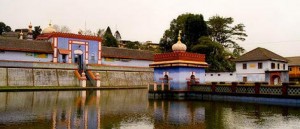
Nisargadhama
Nisargadhama (as it is popularly known as) is an Ecological Park for young and old and a paradise for the nature lovers. This romantic 64-acre island, accessible through a hanging bridge. It gives immense pleasure to all the Nature and Fun loving tourists to wander around the park. Honeymooners (or anybody!!!) can enjoy boating and spend some time together away from the crowd. If you are looking for some extra large fun, then the elephant back ride is deemed perfect. Having local food surrounded by tweeting birds and whispering nature in a Restaurant made from bamboo is definitely bliss! It also has a forest department run guest house and treetop bamboo cottages. A wide variety of wild animals can be found here including dears, peococks and rabbits that comes handy. There is also a children’s playground and orchidarium.
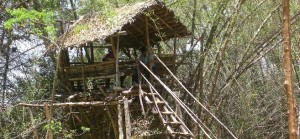
Dubare Forest
Dubare Forest is a natural island of about 11-12 acres. This is a fabulous pick nick place where you can enjoy singing to the karaoke of Mother Nature. Elephants are often found bathing in the river with mahouts helping them with the process. If you have a good smile and a good sense of humor you can get a free ride on the elephant. This is mainly an elephant capturing and training camp of the Forest Department. Giants of the jungle are captured with the help of the local tribesman, The Kurubas, and few tamed or domestic elephants. Fishing is allowed but with the prior permission from the wild life society. The Forest Department maintains cottages/guest houses at Dubare forest. Activities here includes, bird watching, white river rafting, trekking, boating, fishing, camp fire and many more.

Chiklihole Reservoir
Pronounced as ‘Chikli-holey’, it is a large body of water that offers both relaxation and tranquillity; perfect for holidaymakers and nature lovers looking to escape the stresses of their lives back home.The area surrounding Chiklihole reservoir makes this place particularly attractive. Watching the Sunset from here is extremely picturesque and photogenic. The green meadow on one side and thick forest on the other makes this place a great travel destination across Coorg. The Chiklihole reservoir on the tributary of river Kaveri is also a wonderful picnic spot. Please visit this place only if you have enough time after visiting Dubare forest. It is advisable to enjoy your evening in Dubare forest and rush back here for the sunset.

Harangi Dam
Harangi Dam, built across the tributary of river Cauveri, is located at Hadgur village that is around 8 kms from kushalnagar. With a height of 47 mts. and 846 mts. length, the dam attracts people mostly during the monsoon season when the released water roaringly splashes the ground. This place is ideal for weekend picknick with family and friends. Best time to visit the dam is between August to October. Guest house facility is available upon reservation from the public works department. Try to reach Harangi Dam before 5:30pm as it is open only till 6:00pm. Be careful near the dam. Do not leave children unattended at anytime.
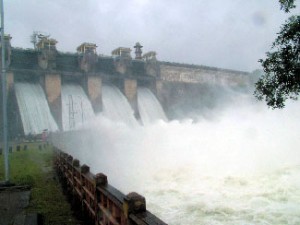
ByleKuppe
The moment you enter this tiny colony the whole world changes!! You feel as if you are in Tibet! ByleKuppe is one of the largest Tibetan settlements in India, around 16000 refugees and nearly 6000 monks and nuns. Set up in 1960, Bylakuppe is a small town situated 6 kms from Kushalnagar or 42 Kms from Mercara, the place has several monastries and the famous among them are the Great Gompa of Sera Je, Sera Mey and the Namdroling monastery. Another important monastery is the Tashi Lhumpo monastery, the seat of the Panchen Lama. Buddhist refugee camps at Bylakuppe have prayer halls which houses beautiful 40 ft idols of Buddha and Padmasambhava.Dalai Lama often visits the place. The friendly people never come out without wearing a heavenly smile. Visitors are wholeheartedly greeted by the decorated shops where you get some genuine Tibetan/Chinese products.

Coffee Estates, Plantations and Farms
The coffee plantation tour is ideal for anyone that wants to experience the culture while eyewitness the production of the freshly brewed coffee they will have in the mountains. Also for those who wishes to see Coorg outside the Metro and tourist area in a safe and enjoyable atmosphere. Hotel guests, whether they drink coffee or not, have an opportunity to see up-close Coorg’s enchanting scenery in style. Visitors are accompanied by the Estate owners who also play the host. You can get the best knowledge on how coffee is grown and how it is sold. People of Coorg are famous for their hospitality. You can also taste typical Veg/Non-veg Coorg meals with prior arrangements with the estate owner. Accomodation and food is often provided within the Coffeefarm and is popularly known as Plantation-stays.
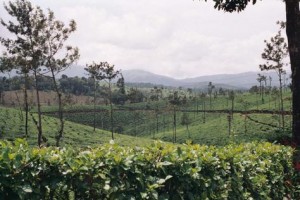
Bhagamandala
Bhagamandala is a pilgrimage place in Kodagu. It is situated on the river Kaveri in its upstream stretches. Bhagamandala is on the banks of the confluence of three rivers, Cauvery, Kannike and the sub terrain Sujyoti, popularly known as “Triveni Sangama”. It is a common practice for pilgrims to take a dip in the triveni sangama and perform rituals to their ancestors before proceeding to Talakaveri, the birthplace of Kaveri. During Tula Sankramana which falls on October 17th or 18th every year, pilgrims assemble here in large numbers. Located about 38 km from the district headquarters Madikeri and is connected from Madikeri, Virajpet and nearby places in Kerala. Government and private buses are available on all of these routes.
Sri Bhagandeshwara temple is a Famous temple near triveni sangama, where Bhagandeshwara (Ishwara), Subramanya, Mahavishnu and Ganapati temples are there.. its also called as Bhagandeshwara Kshetra, The Bhagandeswara temple complex though said to have been built by the Cholas prior to th 11th century follows the gabled roof style of the Kerala temple architecture common on the west coast.
A short distance from Bhagamandala is the temple at Padi, which houses the deity Lord Igguthapp and is considered by many Kodavas to be the most sacred shrine in their homeland.
Bhagamandala is a famous Honey marketing centre, the bee rearing centre here is called Madhuvana and possesses a rare museum of objects related to bee keeping and is the only such centre in the entire state. There is an Apiculture Training Institute run by the state government.
During 1785-1790, the area was occupied by Tipu Sultan. He renamed Bhagamandala to Afesalabad. In 1790 King Dodda Vira Rajendra took Bhagamandala back into an independent Kodagu kingdom.
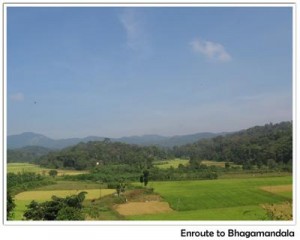
Raja’s Seat
Raja seat which literally means “Seat of the Kings”. It’s a Feast for your eyes on an endless expense of sun kissed greenery.
One of the most enchanting places in Madikeri is the Raja’s Seat, where one can have exquisite views of the sunrise and sunset. This is called raja’s seat because the Coorg Raja’s were known to visit spot together with their consorts to watch the beauty of nature. it’s an Amazing park now.To left of raja seat is the Gandhi Mantap , where the mortal remains of Mahatma Gandhi is kept.Raja seat also has a train goes around raja seat and a dancing Fountain.
